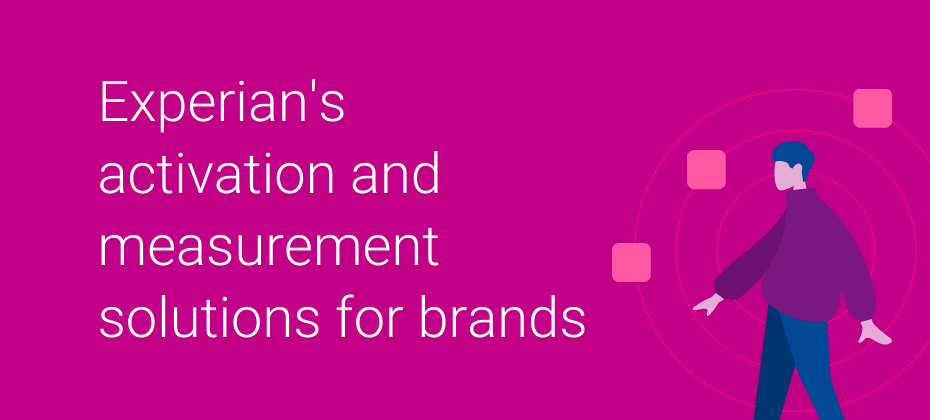
Originally appeared in AdExchanger
Navigating the world of data and identity partners feels like scrolling through a dating app: a sea of options, but only a select few worth swiping right. To find your perfect match, look for a partner who ticks all the right boxes. Here’s your guide to finding your perfect match.
1. Identity resolution: It all starts with a strong foundation

Great identity resolution depends on a rock-solid foundation. The best partners rely on offline data—like names, addresses, and emails—that rarely change, ensuring a consistent view of households, individuals, and their devices over time. You want someone who gives you the same understanding of your audience across every stage of a campaign.
2. In search of: A well-rounded, reliable identity partner
When evaluating identity graphs, it’s essential to distinguish between digital-only graphs, offline graphs, and those rare gems who combine both. Digital graphs rely on digital identifiers, while offline graphs are grounded in persistent identifiers like name, address, and phone number. A partner who offers both creates a more complete and reliable view of consumers across channels, resulting in more effective targeting and measurement.

3. Match rates are like dating profiles—don’t be fooled by the numbers

Match rates can look impressive, but they’re often misleading. They can also vary widely depending on the methodology and the IDs being tested. Some providers inflate match rates by limiting the scope of comparison or tweaking their standards. The real indicators of quality are the depth of the data, the quality of matches, and how often the graph is refreshed. Ideally, your partner updates their graph weekly or monthly. The inclusion of inactive IDs may inflate the perceived scale without reflecting the true addressable audience. It’s like having a profile photo from ten years ago–a major no-no.
4. Authentic origins: Is their data genuine or just a catfish?
Look into your partner’s data sources and place a premium on those with public records or direct to consumer relationships. Ask if they have the experience and expertise when it comes to all aspects of data processing from accuracy to privacy and security. Look for some clear third-party indicators for accuracy, like ratings from Truthset, but there is also a basic reality: either your partner is focused on privacy and accuracy, or they are just playing the scale game. Swipe left on those playing games.

5. The breadth to impress

Depth matters as much as quality. Seek a partner with wide-ranging attributes that span key audience categories like demographics, interests, and purchase behavior. They should offer the flexibility to deliver both granular data scores and broad audience segments, empowering you to reach the right consumers across channels effectively.
6. The total package: Does your partner really have it all?
A true, lifelong partner connects the dots seamlessly, offering a blend of data and identity that link households to devices while layering in rich marketing insights. This approach helps advertisers better understand their customers, reach the right audiences across channels, and measure the impact of their campaigns. The right partner is well-connected and ensures that all the pieces—identity, data, and activation—work in harmony.

7. Future-proof charm: Will they ghost you when cookies crumble?

With the Identifier for Advertisers (IDFAs) gone, cookies on the wane, and IP addresses under scrutiny, a partner’s ability to adapt is critical. The most future-proofed solutions are based on offline identifiers like names and addresses, which are user provided and consented data points–making them more resistant to privacy changes. Additionally, look for partners who have made the necessary investments and are prepared to support the new wave of addressable IDs emerging as alternatives to traditional signals.
8. Privacy savvy: Do they respect boundaries?
As privacy laws evolve, you need a partner with a strong history in privacy compliance and proactive leadership in navigating new regulations. Strong and transparent privacy policies and participation in privacy organizations are a good indicator of trustworthiness, especially as new rules emerge across different states. Look for a partner who takes data privacy as seriously as you do and gives you peace of mind when handling sensitive information.

9. Seamless connectivity: Do they play well with others?

Data is only as useful as it is actionable. Connectivity across platforms is essential, so choose a partner with seamless integrations into the major platforms you rely on for advertising. This ensures your data quality and identity resolution remain intact throughout your campaigns, avoiding loss from multiple handoffs.
10. Killer customer service: Are they in it for the long haul?
A great partner collaborates to solve challenges, not just to sell or upsell. Long-standing partnerships and testimonials about strong customer service are key indicators of reliability. Choose a partner who educates and guides you through technical and strategic challenges, fostering an environment where problem-solving and innovation thrive.

Keep your standards high
Only a handful of companies can meet these rigorous criteria, and you should refuse to settle for a partner that lacks any of these key dimensions. Successfully navigating signal loss, privacy compliance, and seamless omnichannel integration requires extensive resources, robust infrastructure, and years of expertise.
So, swipe right on a partner who can handle the complexities of modern marketing and deliver consistent, scalable successful marketing outcomes. Could we be your perfect match?
Find out if it’s a match today
Latest posts

Audigent, a part of Experian, is excited to announce that curated audience and contextual inventory packages are now accessible on Google Display and Video 360 (DV360), delivered via Index Marketplaces. These premium deals offer industry-leading targeting solutions, combining high-quality data and inventory to enhance scale, value, and performance across connected TV (CTV), display, and online video (OLV). The integration launches with over 250 ready-to-run deals covering various sectors, including some available for DV360 buyers for the first time, such as automotive, B2B, seasonal retail, sports fandom, travel, and weather, among others. Each deal combines exclusive audience data with premium inventory under a single DV360 deal ID. The supply-side activation lets you scale campaigns without cookies or device IDs, so results stay consistent even as traditional tracking disappears. "We’re excited to expand Audigent’s curated, data-enriched packages in DV360 with Index Exchange. Putting Experian’s audiences and Audigent's premium supply inside a single deal ID accelerates smarter decisions for marketers—letting brands activate, test, and see results right away.”Chris Feo, Chief Business Officer, Experian Why these packages stand out Unique targeting and supply packages Each package fuses exclusive data with handpicked inventory and ships as a single, ready-to-trade deal ID. Deep partner bench Audiences are sourced from first-party publisher data as well as data leaders such as Experian, Affinity Answers, Acxiom, Bombora, Circana, Dun & Bradstreet, Resonate, Sports Innovation Lab, The Weather Company, and more, providing buyers with deterministic purchase, intent, behavioral, and lifestyle signals in one flight. Future-proofed addressability Packages rely on Audigent’s identity framework, contextual intelligence, and supply-side data activation rather than third-party cookies or device IDs, keeping reach intact as identifiers fade. Three reasons these packages drive results Signal-agnostic reach: Cookieless, device-less targeting preserves scale today and tomorrow. Instant activation: Traders simply add the pre-curated deal ID to a DV360 line item and go live in seconds. Built-in quality assurance: Exclusive audience data is paired with hand-vetted inventory, so you start closer to KPIs from day one. Direct-to-source media buying that pays off By packaging curated, data-enriched deals directly atop Index Exchange, via the Index Marketplaces platform, Audigent eliminates extra hops and integrates premium partner data into a single price, with no additional data management platform (DMP) fees. That means higher match rates, simplified audience management, and a cleaner, greener path that concentrates spend on top-tier publishers. Paired with Index Exchange’s omnichannel reach, brands see stronger performance and lower waste, no trade-offs required. "Our goal with Index Marketplaces is to streamline access to premium supply, high-quality data, and measurable outcomes. Hosting Audigent's ready-to-run deals on Index lets DV360 buyers tap addressable inventory curated for scale, sustainability, and speed – no extra steps, just better results."Paul Zovighian, Vice President of Marketplaces, Index Exchange Real-world use cases Audigent’s deep data collaboration bench isn’t window dressing; it’s baked into every package. Deterministic signals from Experian and fellow data leaders come pre-loaded, so you tap high-intent, high-match audiences the instant you activate a deal ID. In-market auto shoppers Reach consumers actively researching specific vehicle types, such as compact cars, SUVs, trucks, or luxury models, using deterministic data from Experian. These segments predict purchase intent within the next 180 days, enabling the delivery of accurate messaging at the moment of consideration. B2B account growth Target decision-maker employees at companies segmented by employee count: 11–50, 51–250, or 251+, using Dun & Bradstreet’s data. Or reach small business professionals and business decision-makers via deals utilizing Bombora’s data assets. Sports fandom Engage verified MLB fans based on purchase behavior, powered by Sports Innovation Lab. Extend reach to contextual sports content, including live sports and sports-related programming across CTV and OLV. Seasonal retail bursts Engage gift-givers and in-market segments for gifts and occasions. Target DIY home improvers and verified affinity audiences for home projects. Reach back-to-school families by targeting parents preparing for the school year with Affinity Answers’ event-based segments. Weather-driven behavior Activate campaigns based on how real-time or forecasted weather conditions (like sunny days, outdoor activity suitability, or severe weather alerts) influence mindsets and decisions, powered by The Weather Company's data. "This collaboration integrates The Weather Company’s industry‑leading weather forecast data into DV360, the world’s largest buying platform, enabling real‑time relevance through curated deals. Experian contributes deep expertise in consumer audiences, The Weather Company delivers unmatched precision in timing and location, and Index Exchange adds efficiency and transparency – together creating a streamlined, turnkey solution for activation." Dave Olesnevich, VP of Data and Ad Product, The Weather Company Ready to activate? Search Audigent in DV360’s Marketplace, select the Audigent package that fits your KPIs, and add the deal ID to your line item. Prefer a custom build? Reach out to us at partnershipsales@experian to curate a package tailored to your campaign goals. The quickest path to performance is just one deal ID away. Contact us now Latest posts

Brands want more from their media investments: better insights, more efficient reach, and clear proof of performance. Whether you’re starting with high-quality first-party data or need help reaching new audiences, Experian offers flexible solutions to drive reach among key audiences and to measure the impact. We’ve built two primary activation and measurement solutions tailored to how brands operate, so you can spend less time managing data and more time driving outcomes. Use case 1: First-party insights to activation and measurement Best for: Brands with first-party data looking to deepen their understanding of existing customers, activate intelligently, and measure what matters – all through a single trusted partner. Solution: Audience Engine + Outcomes Audience Engine Audience Engine is our self-service platform designed to help you onboard first-party data, gain key insights into your customers, build custom audiences using our powerful data assets, and activate them across 200+ platforms — all within a single workflow. Outcomes Experian Outcomes closes the loop by measuring real-world results of your campaigns (such as visits, purchases, and website actions) and tying them back to specific media exposures across digital and TV channels. Together, these tools offer a full-funnel audience and measurement solution, from planning and activation to proving performance. Let’s bring this to life A leading athletic retailer partnered with Experian and Yieldmo to drive in-store foot traffic, targeting shoppers likely to buy from their competitors during key sales windows. Using Experian’s Audience Engine, which includes our proprietary and third-party data marketplace, Yieldmo built a high-performing, self-serve targeting strategy for the retailer. By combining Experian Audiences with Partner Audiences from Alliant, Circana, Webbula, and Sports Innovation Lab, Yieldmo was able to build apparel and footwear audiences from the data marketplace including: In-store shopper segments Athleisure purchasers Competitive purchasers Audience Engine also enabled Yieldmo to tap into Experian’s identity graph, expanding cross-channel reach and maximizing campaign scale and precision. And while not used for this campaign, our Outcomes solution allows advertisers to tie media spend to in-store activity, so retailers can measure true business impact. Benefits Understand your customers more deeply To reveal behavioral, demographic, and lifestyle trends. Reach your first-party audiences at scale Across top activation platforms, using Audience Engine’s onboarding capabilities. Increase your brand awareness By reaching prospective audiences, using Experian Audiences, Partner Audiences, and lookalike audiences. Measure campaign effectiveness With Outcomes, which correlates media exposures (digital and/or TV) with offline and online conversions, visits, or sales. Optimize future media buys By using attribution insights to refine targeting, creative, and channel mix based on what’s actually driving results. Use case 2: Activation and measurement Best for: Brands that already know who they want to reach and are looking to activate high-quality, data-driven audiences across their preferred media platforms and want to clearly understand what’s driving performance. Solution: Audiences + Partner Audiences + Outcomes Audiences Experian Audiences are pre-built audience segments grouped by shared attributes from Experian Marketing Data built for activation on-the-shelf of top programmatic, TV, and social destinations like FreeWheel, Magnite, and Madhive, in addition to Audience Engine. Partner Audiences Experian's Partner Audiences are high-quality audience segments sourced directly from 30+ leading third-party data providers like Affinity, Circana, and Dun & Bradstreet. These segments are curated across verticals like Business, CPG, Health, Retail, and Travel, and are available through on top media destinations, in addition to our data marketplace for easy selection and deployment. Outcomes Experian Outcomes helps close the loop by tying real-world results back to media exposures across digital and TV channels. Together, these products empower marketers to activate smarter and prove success with confidence. Let's bring this to life A leading fashion brand set out to grow their customer base by reaching high-intent shoppers where they spend their time: online. Their goal: drive e-commerce conversions through a programmatic campaign powered by The Trade Desk. To do it, they needed more than just reach, they needed accuracy. That’s where Experian came in. On The Trade Desk, the brand quickly discovered Experian’s prebuilt audience segments, readily available and easy to activate. They selected: Age Range: 25–44 Women’s Fashion Frequent Spenders: Households identified as frequent purchasers of women’s apparel, cosmetics, jewelry, and accessories—based on verified, consumer-reported transactions from the past 24 months. These segments gave the brand confidence that it was putting its message in front of the right consumers, those most likely to engage and buy. To understand whether their campaign was driving results beyond impressions, the brand implemented a site pixel to capture both top-of-funnel visitation and bottom-of-funnel conversions. Using Experian’s Outcomes solution, they were able to close the loop—tying ad exposure directly to e-commerce sales. The Outcomes report showed clear campaign lift, highlighting which channels and audience segments performed best. Armed with these insights, the brand refined their targeting and messaging for future media buys—boosting ROI with each iteration. Benefits Reach your ideal audience at scale By activating Experian Audiences and Partner Audiences off the shelf at digital and TV platforms. Access privacy-conscious, diverse data Curated by 30+trusted data providers in verticals like Business, CPG, Health, Retail, and Travel without needing to manage multiple data contracts. Understand what’s working Through Outcomes reporting, which connects media exposure to offline and online outcomes like conversions, purchases, or visits. Continuously improve performance By using attribution insights to inform audience selection, creative strategy, and media channel mix for future campaigns. Bring this to your brand Experian’s activation and measurement solutions for brands gives you the tools to act with clarity: from onboarding your first-party data to reaching new customers and tying media back to real results. Whether you’re starting with deep customer insights or building campaigns from scratch, here’s how our solution helps: Audience Engine Onboard your first-party data, gain insights into audience composition, build custom audiences using Experian and Partner Audiences, and activate them across 200+ leading platforms — all through a centralized, self-service platform. Audiences and Partner Audiences Reach high-intent prospects using Experian’s syndicated audiences or custom-built segments from partners like Circana, Dun & Bradstreet, and more. Outcomes Understand what worked. See how media exposure correlates with actions like store visits, quote requests, site activity, or purchases. Every element is built to help you scale campaigns, improve addressability, and tie media spend to results that matter—without the overhead of multiple vendors or disjointed systems. Ready to see it in action? Get in touch with our team. Latest posts

1,000+ ready-made segments, available for activation within Nexxen Audigent, a part of Experian, has officially launched its audiences in the Nexxen demand-side platform (DSP), pairing premium publisher audiences with Nexxen’s streamlined connected television (CTV) and omnichannel buying workflow. Audigent transforms real engagement from premium publishers into over 1,000 ready-to-activate segments—spanning beauty, finance, travel, and more. Three key benefits Signal quality Verified publisher data drives higher match rates and wider look-alike reach. Media impact Reach up to 92 million entertainment fans, 78 million retail shoppers, or 71 million finance intenders across CTV, online video (OLV), and display without guesswork. Privacy and compliance Every segment is built from opt-in, first-party data and delivered through Audigent’s privacy-by-design framework. How Audigent and Nexxen boost your campaigns Now live in the Nexxen DSP, Audigent’s premium audiences plug directly into your existing buying workflow—making it easier than ever to plan, activate, and optimize at scale. Audigent utilizes cookieless, first-party IDs sourced directly from its premium publisher network, allowing advertisers to future-proof campaigns and continue to reach real people across browsers, devices, and CTV. Vertical use cases Auto Target auto intenders as they research new models, then retarget them on CTV during primetime motorsports broadcasts. Retail and CPG Engage retail shoppers with dynamic product ads ahead of peak sales weekends, bridging display and CTV for sequential storytelling. Travel and Hospitality Reach travel planners with destination-specific offers the moment they begin searching for flights. Finance Serve relevant credit card or fintech messaging to finance enthusiasts researching personal finance content. Premium audiences, measurable performance As a part of Experian, Audigent’s audience solution complements our broader identity resolution and activation capabilities, ensuring consistency across every channel. Together with Nexxen’s unified tech stack, advertisers can launch ads faster while respecting consumer privacy. Audience data, targeting, and media all sit in one workflow, making results easy to see and optimize. Contact us Latest posts